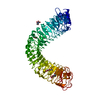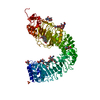[English] 日本語
 Yorodumi
Yorodumi- PDB-4mn8: Crystal structure of flg22 in complex with the FLS2 and BAK1 ecto... -
+ Open data
Open data
- Basic information
Basic information
| Entry | Database: PDB / ID: 4mn8 | |||||||||
|---|---|---|---|---|---|---|---|---|---|---|
| Title | Crystal structure of flg22 in complex with the FLS2 and BAK1 ectodomains | |||||||||
 Components Components |
| |||||||||
 Keywords Keywords | TRANSFERASE/TRANSFERASE RECEPTOR / FLS2 /  BAK1 / flg22 / BAK1 / flg22 /  Flagellin / Flagellin /  plant immunity / plant immunity /  Leucine-rich repeat / TRANSFERASE-TRANSFERASE RECEPTOR complex Leucine-rich repeat / TRANSFERASE-TRANSFERASE RECEPTOR complex | |||||||||
| Function / homology |  Function and homology information Function and homology information regulation of anion channel activity / defense response by callose deposition in cell wall / regulation of anion channel activity / defense response by callose deposition in cell wall /  transmembrane receptor protein serine/threonine kinase activity / transmembrane receptor protein serine/threonine kinase activity /  receptor serine/threonine kinase binding / receptor serine/threonine kinase binding /  endomembrane system / detection of bacterium / endomembrane system / detection of bacterium /  transmembrane receptor protein tyrosine kinase activity / transmembrane receptor protein tyrosine kinase activity /  receptor-mediated endocytosis / receptor-mediated endocytosis /  receptor protein-tyrosine kinase / defense response ... receptor protein-tyrosine kinase / defense response ... regulation of anion channel activity / defense response by callose deposition in cell wall / regulation of anion channel activity / defense response by callose deposition in cell wall /  transmembrane receptor protein serine/threonine kinase activity / transmembrane receptor protein serine/threonine kinase activity /  receptor serine/threonine kinase binding / receptor serine/threonine kinase binding /  endomembrane system / detection of bacterium / endomembrane system / detection of bacterium /  transmembrane receptor protein tyrosine kinase activity / transmembrane receptor protein tyrosine kinase activity /  receptor-mediated endocytosis / receptor-mediated endocytosis /  receptor protein-tyrosine kinase / defense response / endosome membrane / receptor protein-tyrosine kinase / defense response / endosome membrane /  non-specific serine/threonine protein kinase / non-specific serine/threonine protein kinase /  endosome / defense response to bacterium / endosome / defense response to bacterium /  phosphorylation / phosphorylation /  signaling receptor binding / protein serine kinase activity / protein serine/threonine kinase activity / signaling receptor binding / protein serine kinase activity / protein serine/threonine kinase activity /  ATP binding / ATP binding /  membrane / identical protein binding / membrane / identical protein binding /  plasma membrane plasma membraneSimilarity search - Function | |||||||||
| Biological species |   Arabidopsis thaliana (thale cress) Arabidopsis thaliana (thale cress) | |||||||||
| Method |  X-RAY DIFFRACTION / X-RAY DIFFRACTION /  SYNCHROTRON / SYNCHROTRON /  MOLECULAR REPLACEMENT / Resolution: 3.062 Å MOLECULAR REPLACEMENT / Resolution: 3.062 Å | |||||||||
 Authors Authors | Chai, J. / Sun, Y. / Han, Z. | |||||||||
 Citation Citation |  Journal: Science / Year: 2013 Journal: Science / Year: 2013Title: Structural basis for flg22-induced activation of the Arabidopsis FLS2-BAK1 immune complex. Authors: Sun, Y. / Li, L. / Macho, A.P. / Han, Z. / Hu, Z. / Zipfel, C. / Zhou, J.M. / Chai, J. | |||||||||
| History |
|
- Structure visualization
Structure visualization
| Structure viewer | Molecule:  Molmil Molmil Jmol/JSmol Jmol/JSmol |
|---|
- Downloads & links
Downloads & links
- Download
Download
| PDBx/mmCIF format |  4mn8.cif.gz 4mn8.cif.gz | 394.3 KB | Display |  PDBx/mmCIF format PDBx/mmCIF format |
|---|---|---|---|---|
| PDB format |  pdb4mn8.ent.gz pdb4mn8.ent.gz | 323.1 KB | Display |  PDB format PDB format |
| PDBx/mmJSON format |  4mn8.json.gz 4mn8.json.gz | Tree view |  PDBx/mmJSON format PDBx/mmJSON format | |
| Others |  Other downloads Other downloads |
-Validation report
| Arichive directory |  https://data.pdbj.org/pub/pdb/validation_reports/mn/4mn8 https://data.pdbj.org/pub/pdb/validation_reports/mn/4mn8 ftp://data.pdbj.org/pub/pdb/validation_reports/mn/4mn8 ftp://data.pdbj.org/pub/pdb/validation_reports/mn/4mn8 | HTTPS FTP |
|---|
-Related structure data
| Related structure data |  4mnaC  3rgzS C: citing same article ( S: Starting model for refinement |
|---|---|
| Similar structure data |
- Links
Links
- Assembly
Assembly
| Deposited unit | 
| ||||||||
|---|---|---|---|---|---|---|---|---|---|
| 1 |
| ||||||||
| Unit cell |
|
- Components
Components
-Protein , 2 types, 2 molecules AB
| #1: Protein | Mass: 85524.281 Da / Num. of mol.: 1 / Fragment: FLS2-LRR UNP RESIDUES 25-800 Source method: isolated from a genetically manipulated source Source: (gene. exp.)   Arabidopsis thaliana (thale cress) / Gene: FLS2, At5g46330, MPL12.13, MPL12.8 / Cell (production host): high five / Production host: Arabidopsis thaliana (thale cress) / Gene: FLS2, At5g46330, MPL12.13, MPL12.8 / Cell (production host): high five / Production host:   Spodoptera frugiperda (fall armyworm) Spodoptera frugiperda (fall armyworm)References: UniProt: Q9FL28,  non-specific serine/threonine protein kinase non-specific serine/threonine protein kinase |
|---|---|
| #2: Protein | Mass: 24631.170 Da / Num. of mol.: 1 / Fragment: BAK1-LRR UNP RESIDUES 1-220 Source method: isolated from a genetically manipulated source Source: (gene. exp.)   Arabidopsis thaliana (thale cress) / Gene: BAK1, ELG, SERK3, At4g33430, F17M5.190 / Cell (production host): high five / Production host: Arabidopsis thaliana (thale cress) / Gene: BAK1, ELG, SERK3, At4g33430, F17M5.190 / Cell (production host): high five / Production host:   Spodoptera frugiperda (fall armyworm) Spodoptera frugiperda (fall armyworm)References: UniProt: Q94F62,  receptor protein-tyrosine kinase, receptor protein-tyrosine kinase,  non-specific serine/threonine protein kinase non-specific serine/threonine protein kinase |
-Protein/peptide / Non-polymers , 2 types, 17 molecules C

| #3: Protein/peptide | Mass: 2275.502 Da / Num. of mol.: 1 / Source method: obtained synthetically / Details: This sequence is synthetic produce |
|---|---|
| #6: Chemical | ChemComp-SO4 /  Sulfate Sulfate |
-Sugars , 2 types, 10 molecules 
| #4: Polysaccharide | 2-acetamido-2-deoxy-beta-D-glucopyranose-(1-4)-2-acetamido-2-deoxy-beta-D-glucopyranose / Mass: 424.401 Da / Num. of mol.: 1 / Mass: 424.401 Da / Num. of mol.: 1Source method: isolated from a genetically manipulated source |
|---|---|
| #5: Sugar | ChemComp-NAG /  N-Acetylglucosamine N-Acetylglucosamine |
-Experimental details
-Experiment
| Experiment | Method:  X-RAY DIFFRACTION / Number of used crystals: 1 X-RAY DIFFRACTION / Number of used crystals: 1 |
|---|
- Sample preparation
Sample preparation
| Crystal | Density Matthews: 4.52 Å3/Da / Density % sol: 72.81 % |
|---|---|
Crystal grow | Temperature: 298 K / Method: vapor diffusion, hanging drop / pH: 4 Details: 0.1M citirc acid pH 4.0, 2.5M ammonium sulfate, 8% (v/v) PEG 400, VAPOR DIFFUSION, HANGING DROP, temperature 298K |
-Data collection
| Diffraction | Mean temperature: 298 K |
|---|---|
| Diffraction source | Source:  SYNCHROTRON / Site: SYNCHROTRON / Site:  SSRF SSRF  / Beamline: BL17U / Wavelength: 1 Å / Beamline: BL17U / Wavelength: 1 Å |
| Detector | Type: ADSC QUANTUM 210 / Detector: CCD / Date: Jul 12, 2012 |
| Radiation | Monochromator: SAGITALLY FOCUSED Si(111) / Protocol: SINGLE WAVELENGTH / Monochromatic (M) / Laue (L): M / Scattering type: x-ray |
| Radiation wavelength | Wavelength : 1 Å / Relative weight: 1 : 1 Å / Relative weight: 1 |
| Reflection | Resolution: 3.05→50 Å / Num. all: 38964 / Num. obs: 38653 / % possible obs: 99.2 % / Observed criterion σ(F): 2 / Observed criterion σ(I): 1 / Redundancy: 3.5 % |
- Processing
Processing
| Software |
| ||||||||||||||||||||||||||||||||||||||||||||||||||||||||||||||||||||||||||||||||||||||||||||||||||||
|---|---|---|---|---|---|---|---|---|---|---|---|---|---|---|---|---|---|---|---|---|---|---|---|---|---|---|---|---|---|---|---|---|---|---|---|---|---|---|---|---|---|---|---|---|---|---|---|---|---|---|---|---|---|---|---|---|---|---|---|---|---|---|---|---|---|---|---|---|---|---|---|---|---|---|---|---|---|---|---|---|---|---|---|---|---|---|---|---|---|---|---|---|---|---|---|---|---|---|---|---|---|
| Refinement | Method to determine structure : :  MOLECULAR REPLACEMENT MOLECULAR REPLACEMENTStarting model: 3RGZ Resolution: 3.062→29.962 Å / SU ML: 0.4 / σ(F): 0 / Phase error: 31.09 / Stereochemistry target values: ML
| ||||||||||||||||||||||||||||||||||||||||||||||||||||||||||||||||||||||||||||||||||||||||||||||||||||
| Solvent computation | Shrinkage radii: 0.9 Å / VDW probe radii: 1.11 Å / Solvent model: FLAT BULK SOLVENT MODEL | ||||||||||||||||||||||||||||||||||||||||||||||||||||||||||||||||||||||||||||||||||||||||||||||||||||
| Refinement step | Cycle: LAST / Resolution: 3.062→29.962 Å
| ||||||||||||||||||||||||||||||||||||||||||||||||||||||||||||||||||||||||||||||||||||||||||||||||||||
| Refine LS restraints |
| ||||||||||||||||||||||||||||||||||||||||||||||||||||||||||||||||||||||||||||||||||||||||||||||||||||
| LS refinement shell | Refine-ID: X-RAY DIFFRACTION / Total num. of bins used: 14
| ||||||||||||||||||||||||||||||||||||||||||||||||||||||||||||||||||||||||||||||||||||||||||||||||||||
| Refinement TLS params. | Method: refined / Refine-ID: X-RAY DIFFRACTION
| ||||||||||||||||||||||||||||||||||||||||||||||||||||||||||||||||||||||||||||||||||||||||||||||||||||
| Refinement TLS group |
|
 Movie
Movie Controller
Controller












 PDBj
PDBj






